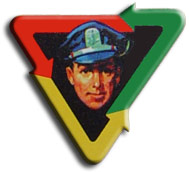Walt Disney Comics Digest #7
Even without it, the memory of some comic books linger, even after they have been lost or thrown away. This is one of those for me. I wish I could show you the cover for this comic, but it is either rare or those people who have copies just haven’t gotten around to scanning it into a Website for my use. I know I saw this comic in Woolworth’s in downtown Milwaukee. Unless I looked it up, I couldn’t even tell you what the other stories were in the book, but there was one story included that introduced me to Carl Barks, “The Good Duck Artist.”
The story was Barks’s “Gyro Gearloose and Gus Goose on the Dream Planet.” Gus, Grandma Duck’s lazy farmhand, describes to Gyro the planet of his dreams where the denizens are all as lazy as he is and none the worse for it. Gus even points out where it is in the sky. Gyro, being an inventor, has a rocket capable of the flight; soon, he and Gus are on their way. Upon their arrival, Gus is delighted, and Gyro disheartened, by the laziness of the citizens—who are very goose-like in appearance—beings who refuse to make a minimum effort for anything. For instance, after Gus plops himself down under a tree to join in on the laziness, the person next to him says he is hungry. As luck would have it, an apple falls from the tree within an inch of the beings hand. Gus points out that he could reach out and pick up that apple. The response is that that would be too much work, soon enough, an apple will fall into his open hand.
Gyro, in a naïve effort to help progress along, picks up a fallen tree branch and uses it to shake an apple-bearing branch. So many apples fall that they carry Gus’s new buddy-in-lolling off and into a river. Though wet, he sees that the apples helped him do less work because he didn’t have to walk to the river (plus it allowed him to get a drink without having to wait for it to rain). First, apples are used for transport, but pumpkins as carriages quickly replace them and then gravity is replaced (movement was limited to just rolling downhill) as the new automobiles are powered by rubber band engines. As Gus watches his utopia slip away, he and Gyro see the telegraph, telephone, and rockets invented seemingly within moments of the original apple roll into the river. Worn out by just watching all the activity in the name of doing less, Gus tells Gyro it is time to go back to Grandma’s farm. Gyro agrees, taking the branch that started it all with him. As they head back, Gus takes the branch, leans it into the floor, and rests himself into its crook. On response to Gyro, Gus says that at least he can still dream of his dream planet.
I was around eight years old when I first read the story and probably beginning to truly understand differences in quality of a comic book based on just looking at the art. I mean, I was aware that Batman was drawn in Justice League was different from how he was drawn in his own comic, but until I read this story I never been viscerally affected by the differences. There were other stories in that digest featuring the Duck characters, but I just wasn’t as engaged by those as I had been by “Dream Planet.”
There were other Disney comics around the house, but now I only enjoyed the Duck stories by whoever (alone or in tandem) had written and drawn “Dream Planet,” the unknown “Good Duck Artist.” I was twelve or thirteen when I read The Comic-Book Book and learned that the writer/artist was Carl Barks. When I was eight, however, I didn’t need to know the name because it was the stories he created that mattered.
On a larger scale, I can mark this story as being the one where I started to be discriminating. Not that I wouldn’t have read every comic book printed if possible, but unless the art or story weren’t where I expected them to be, even at eight or nine, I was disappointed. For example, it appears that everyone else who was reading comics in 1969/1970 worships at the altar of Dennis O’Neil and Neal Adams, first for their work on Green Lantern, then for their post-Batmania Batman. I felt cheated when I read any of those comics because I thought the stories boring and had trouble following the art. At nine years old, I was an opinionated comic fan. Thank you, “Gyro Gearloose and Gus Goose on the Dream Planet,” for starting me along that path.
By the way, while I have grudgingly accepted O’Neil’s and Adams’s work with Batman, I’ve yet to find anything in their work with Green Lantern. Green Arrow gaining a beard and an attitude doesn’t make up for my nine-year-old self not getting to read more stories by John Broome and Gil Kane. But that’s just me.

